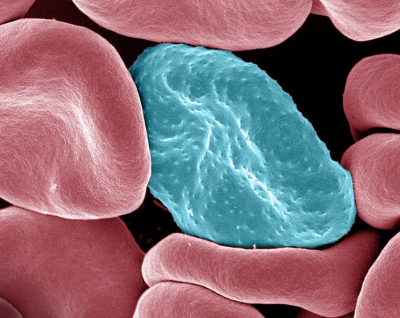Biological Clocks of People and Malaria Parasites Tick in Tune

The team of researchers at Duke University, Florida Atlantic University and the Armed Forces Research Institute of Medical Sciences says the findings could pave the way to new anti-malarial drugs that throw malaria’s internal clock out of step with its host, essentially “jet-lagging” the parasites.
“We have a reason to care about this,” said senior author Steve Haase, professor of biology at Duke. “We're on our last line of drugs, artemisinin-based combination therapies, and we’re already seeing resistance to those in southeast Asia. Exploring some new ideas for fighting malaria makes sense.”
When someone has malaria, a deadly loop repeats itself inside their body. The disease’s recurring fever spikes are caused by microscopic Plasmodium parasites that invade the person’s red blood cells, multiply, and then burst out in unison, spewing into the bloodstream by the millions to invade other cells and begin the cycle anew.
This cycle repeats itself every 24, 48 or 72 hours depending on the Plasmodium species. Which got scientists wondering: could the parasites be coordinating in some way with the 24-hour circadian rhythms of their hosts?
To find out, the researchers collected blood from 10 people who tested positive for malaria caused by Plasmodium vivax, the predominant species of malaria parasite found in Asia and Latin America.
Then they analyzed the RNA in those samples every three hours over two days to figure out which genes were active as the parasites matured inside their victim’s red blood cells. Using a technique called RNA sequencing, the research team tracked the expression of more than 1,000 genes in both the patients’ immune cells and in the parasites lurking in their blood.
The researchers identified hundreds of genes that follow a clock-like rhythm, ramping up at certain times of day and switching off at others. Using this data, they developed a way to calculate the internal clock time for each patient and also for their parasites. Then they calculated how well the rhythms of gene expression were aligned.
Plasmodium vivax parasites have a life cycle that repeats every 48 hours. Sure enough, for every turn of the parasite clock, the 24-hour body clock of their host went around twice.
The team found that not every patient’s 24-hour internal clock ran on exactly the same schedule. Some had cycles that began earlier in the day; some later. But no matter how a person’s biological rhythms were shifted, the cycling genes in their malaria parasites were aligned to match.
Researchers already knew that malaria parasites have their own internal timekeeping mechanism. In a 2020 study, Haase and colleagues determined that, even when grown outside the body, without cues like their host’s meals or sleep cycles to help orient them in time, malaria parasites can still keep a beat. Their rhythmicity is thanks an internal metronome that ticks of its own accord and causes the parasite’s genes to ramp up and down at regular intervals.
But the new study shows something more. “What these results suggest is that the parasite clock and the host clock are talking to each other,” Haase said.
"We have a reason to care about this. We're on our last line of drugs, artemisinin-based combination therapies, and we’re already seeing resistance to those in southeast Asia. Exploring some new ideas for fighting malaria makes sense."
Steve Haase, professor of biology at Duke
Scientists still don’t know what drives malaria parasites to coordinate their rhythms with those of their host. “The parasites are likely taking advantage of their host’s internal rhythms to achieve their own ends,” Haase said, but the nature of the advantage is unclear.
One theory is that the parasites schedule their emergence from red blood cells to avoid times when their victim’s immune system is most active, making themselves less vulnerable to attack.
“They could also be timing their developmental cycle so they have the proper nutrition,” Haase said. “We don't know. So that's a big question.”
The United States has been malaria-free for more than 70 years, but the disease is still a leading cause of death in poorer and tropical parts of the world, killing 619,000 people in 2021 alone, most of them children.
Part of the reason is malaria’s ability to evade attack. Medicines for malaria have been around for hundreds of years, but many of the drugs in the existing arsenal are losing their effectiveness as parasite populations in certain parts of the world develop ways around them.
If they can figure out how malaria parasites stay in step in humans, the researchers say it may be possible to develop new drugs that decouple the parasite’s clock from that of its host, and thereby help the immune system better fight the invaders.
Findings in other host species are promising. In mice, malaria parasites whose rhythms are out of sync with their hosts are half as effective at spreading infection.
As a next step, the researchers are trying to figure out exactly how the parasite and human clocks ‘communicate’ with each other so that their cycles line up.
“There have to be some molecular signals that they're passing back and forth to each other,” Haase said. “We don't know what they are, but if we can disrupt them, then we might have a shot at an intervention.”
This research was supported by grants from the Defense Advanced Research Projects Agency (D12AP00025), the National Institutes of Health (R01 GM126555-0), and the National Science Foundation (DMS 1847144).
Citation
"The Parasite Intraerythrocytic Cycle and Human Circadian Cycle Are Coupled During Malaria Infection," Francis C. Motta, Kevin McGoff, Robert C. Moseley, Chun-Yi Cho, Christina M. Kelliher, Lauren M. Smith, Michael S. Ortiz, Adam R. Leman, Sophia A. Campione, Nicolas Devos, Suwanna Chaorattanakawee, Nichaphat Uthaimongkol, Worachet Kuntawunginn, Chadin Thongpiam, Chatchadaporn Thamnurak, Montri Arsanok, Mariusz Wojnarski, Pattaraporn Vanchayangkul, Nonlawat Boonyalai, Philip L. Smith, Michele Spring, Krisada Jongsakul, Ilin Chuang, John Harer, Steven B. Haase. Proceedings of the National Academy of Sciences, June 6, 2023. DOI: 10.1073/pnas.2216522120.
Copy
